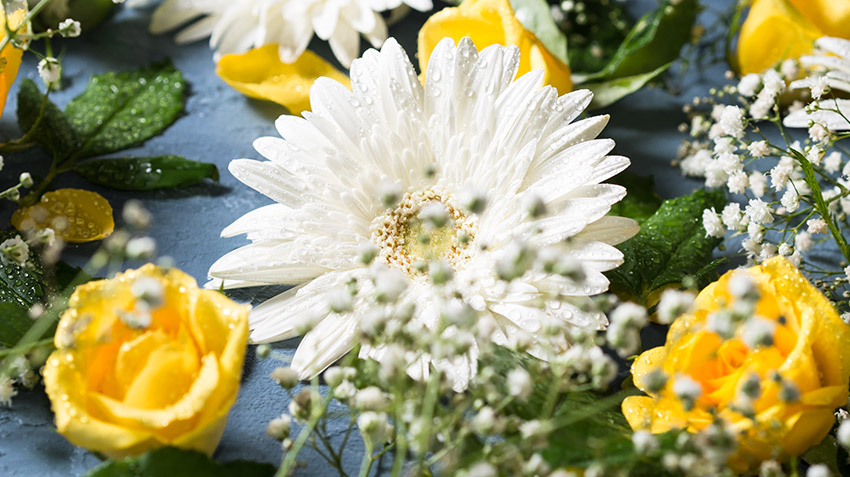
Flowers have long been meaningful in honoring and remembering loved ones at funerals.
But does the color of these flowers hold any specific significance? The answer is yes—flower colors carry distinct meanings, making it possible to select arrangements that beautifully express emotions, respect, and memories of the deceased. Choosing appropriate flower colors for funerals involves understanding color symbolism, considering the deceased’s personality, and being mindful of cultural traditions.
In this post, we’ll explore the significance of various flower colors and offer practical guidance for selecting arrangements that best convey love and remembrance.
1. The Symbolism of Flower Colors
Flower colors at funerals often go beyond aesthetics; they play a powerful role in conveying messages. Color psychology suggests that different colors can evoke unique emotions, allowing colour selection to reflect the deceased’s life and relationships. Families can feel a greater sense of connection as they pay tribute to their loved one by choosing flowers that embody the qualities of peace, love, or dignity.
White, for example, is a universal symbol of purity and peace, often chosen to represent a serene goodbye. Red represents love and respect, while pink conveys admiration. These colors, among others, can serve as a personal message from the family, adding depth to the funeral’s atmosphere.
2. Choosing the Right Flowers Based on Personality
Personalizing flower colors for funerals to reflect the deceased’s personality or preferences is a touching way to honor them. If the individual had a favorite color, you could choose flowers in that shade to add a sense of familiarity and warmth to the service. For instance, a person who had a joyful disposition might be represented through cheerful yellow flowers, while someone who was deeply spiritual may be honored with purple blooms.
Consider aligning flower choices with the individual’s interests or hobbies. A nature lover may be remembered with green foliage arrangements, symbolizing growth and connection to the outdoors. These thoughtful color choices can give attendees a comforting sense of the deceased’s presence and create an intimate environment for remembrance.
3. Cultural Considerations in Flower Color Selection
In addition to personal meaning, cultural factors often influence flower colors at funerals. Different cultures have specific traditions and colors that are considered appropriate or respectful. For instance, white is widely accepted as a traditional funeral color in many Western cultures, symbolizing peace and purity. However, in some Eastern cultures, white represents mourning and is worn by family members during services.
Being mindful of cultural preferences and discussing them with family members can prevent any unintentional missteps. If the family follows certain cultural practices, working with a florist familiar with those traditions can help ensure that the arrangements honor those customs. Respecting these cultural nuances through flower color selection provides an added layer of reverence to the service.
Traditional Flower Colors for Funerals and Their Meanings
1. White Flowers
White is the most traditional and widely accepted color for funeral flowers, symbolizing purity, peace, and innocence. Common white flowers used in funeral arrangements include lilies, roses, and chrysanthemums. Lilies, in particular, are often chosen for funerals as they represent the restored innocence of the deceased’s soul.
White flowers are generally suited for all types of services, whether traditional or religious, as they convey a sense of tranquility and grace.
2. Red Flowers
Red flowers symbolize love, respect, and sometimes deep admiration. Red roses, carnations, and tulips are commonly chosen to express deep love and loss. For families wishing to emphasize the close bond they shared with the deceased, red flowers can add a powerful expression of that connection.
Red flowers are often used in the funeral of a close family member, like a spouse or parent, as they carry a bold message of respect and enduring love.
3. Pink Flowers
Pink, a gentler hue of red, represents grace, admiration, and sometimes gentle love. Pink carnations, peonies, and lilies are popular choices in funeral arrangements. While pink is subtle, it can convey warmth and tenderness, making it suitable for memorials of those who were compassionate, gentle, or loving.
Pink flowers are particularly suited for services honoring women or younger individuals, as they radiate grace and affection.
4. Yellow Flowers
Yellow flowers, symbolizing friendship and joy, may not always be the first choice for funerals, but they can be quite meaningful in the right context. Daffodils, sunflowers, and yellow tulips bring a warm, positive energy, making them a thoughtful choice when celebrating a life well-lived. While yellow can signify cheerfulness, it may not always be seen as appropriate for somber ceremonies; however, it can beautifully reflect the spirit of an individual who brought joy to others.
Choosing yellow flowers for a memorial service or celebration of life can honor someone who was known for their positive outlook and friendships.
5. Purple Flowers
Purple flowers, which convey dignity, respect, and spirituality, are an elegant addition to funeral arrangements. Lavender, iris, and orchids are commonly used purple flowers, suitable for services that wish to highlight the spiritual and dignified aspects of the deceased’s life. This color is often associated with grace and can evoke a calming effect on attendees, making it ideal for those who are admired for their strength and composure.
Practical Tips for Selecting Funeral Flowers
Choosing the appropriate flower colors for funerals can feel overwhelming, especially during an emotionally challenging time. Working with a professional florist who understands the symbolism of flower colors can make the process easier and ensure arrangements are tasteful and meaningful.
- Coordinate with the family’s wishes: Before finalizing any arrangement, it’s essential to understand the family’s preferences. Some families may have specific requests regarding flower colors, especially if the deceased had particular preferences or if there are cultural considerations.
- Consider the type of service: For traditional funerals, white and subdued colors are generally preferred. However, celebrations of life or non-traditional services may embrace a broader color palette to reflect the person’s vibrant life.
- Seasonality and availability: Certain flowers may not be in season, which can impact availability and cost. Opting for seasonal flowers not only makes it easier to source fresh blooms but also allows for more affordable options.
- Work with a florist: Florists experienced in funeral arrangements can provide guidance on appropriate colors and flower types. They can also help create arrangements that complement each other and fit the mood of the service.
Frequently Asked Questions
Below are some commonly asked questions to consider:
1. Can funeral flowers be a mix of multiple colors, or should they be kept uniform?
Yes, it’s appropriate to have a mix of colors in funeral flower arrangements. Multiple colors can capture different aspects of a person’s life, personality, and the emotions they evoked. For example, combining white and purple flowers might reflect both peace and spirituality. Mixing colors can add depth to the arrangement and allow for a more personalized tribute, especially for services that aim to celebrate a life well-lived.
2. Are there specific flowers or colors that should be avoided for funerals?
While flower selection is largely based on personal or cultural preferences, some people may choose to avoid overly bright colors like neon tones, as they might feel too vibrant for a solemn occasion. Additionally, some cultures or families may have specific taboos around certain colors, so it’s wise to ask if there are any preferences or sensitivities, especially if the service involves cultural or religious traditions.
3. How can I personalize funeral flowers without focusing on color?
Beyond color, funeral flowers can be personalized through flower types that hold special meaning to the deceased, such as their favorite flowers or those that represent their birth month. The arrangement style can also be personalized—wreaths, bouquets, or arrangements shaped to represent a favorite hobby or profession are thoughtful ways to honor someone’s unique life and passions.
Flower Colors for Funerals Matter More Than You Think
Selecting flower colors for funerals is a deeply personal process that reflects the relationship, memories, and sentiments tied to the deceased. Each color holds meaning, from the peace of white flowers to the dignity of purple blooms. By considering the deceased’s personality, cultural traditions, and the family’s wishes, it’s possible to create floral tributes that offer solace and comfort to those grieving.
Funeral flowers play an important role in helping families and friends honor their loved ones, making thoughtful color selection a meaningful part of the farewell process. Whether choosing white lilies for purity or yellow sunflowers for joy, each bloom is a gentle reminder of a life that was loved and cherished.
If you’re not sure how to go about picking the ideal flowers for your loved one’s funeral, speak with a professional funeral services provider today.



